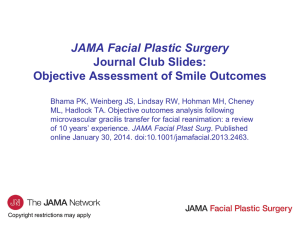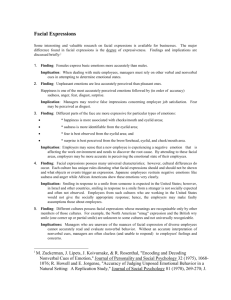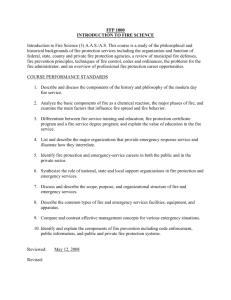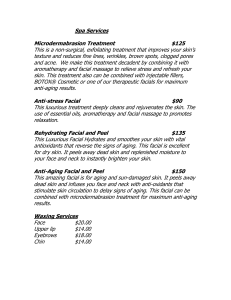A Contemporary Approach to Facial Reanimation
advertisement
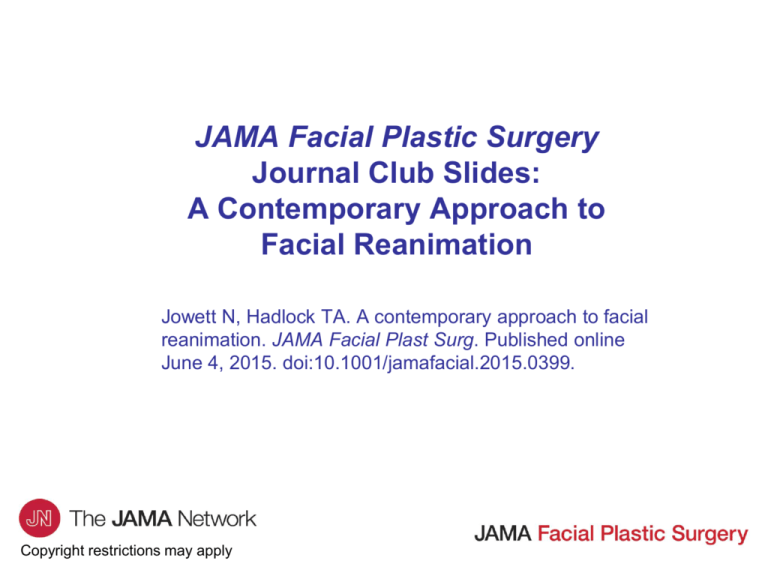
JAMA Facial Plastic Surgery Journal Club Slides: A Contemporary Approach to Facial Reanimation Jowett N, Hadlock TA. A contemporary approach to facial reanimation. JAMA Facial Plast Surg. Published online June 4, 2015. doi:10.1001/jamafacial.2015.0399. Copyright restrictions may apply Introduction • Management of facial palsy (FP) is dictated by the pattern and time course of dysfunction. • Therapeutic options include pharmaceutical agents, corneal protective measures, physical therapy, chemodenervation agents, fillers, and a myriad of surgical procedures. • The role of the clinician is to identify and tailor management to the patient’s unique pattern of dysfunction, with targeted interventions applied to the affected facial zones. Copyright restrictions may apply Purpose • This article summarizes a contemporary approach to the management of facial nerve insults. Copyright restrictions may apply Relevance to Clinical Practice • Muscles innervated by the facial nerve are pivotal to nonverbal communication, corneal and hair cell protection, nasal breathing, mastication, and articulation. • Injury to the facial nerve results in functional, communicative, and social impairment with profound negative impact on the quality of life and emotional well-being of the patient. • Establishing the correct diagnosis is paramount. • Conservative, medical, and surgical options exist to minimize the sequelae of acute and long-standing flaccid FP (FFP) and nonflaccid (synkinetic) FP (NFFP). Copyright restrictions may apply Relevance to Clinical Practice Acute FFP (top) and long-standing NFFP (bottom) in Ramsay-Hunt syndrome (varicella-zoster viral FP). Complete flaccid paralysis on the affected side (asterisk) is demonstrated at rest (A) and with brow elevation (B), gentle eye closure (C), full-effort eye closure (D), gentle smile (E), full-effort smile (F), lip pucker (G), and lower lip depression (H). The patient lacks Bell phenomenon (C, D). One year following symptom onset, the affected brow remains depressed, while hyperactivity has developed in the orbicularis oculi, mentalis, and platysma muscles at rest (I). Volitional brow elevation remains impaired (J), while marked brow synkinesis is present with eye closure (K, L). As is usual in NFFP, eye closure is adequate (K, L). Smile symmetry is improved with light effort (M); commissure restriction is noted with full-effort smile. Near normal return to function of the orbicularis oris muscle is noted (O). Lip depressor function remains weak on the affected side (P). Periocular, mentalis, and platysmal synkinesis is worsened by smile, pucker, and lip depression (N-P). Copyright restrictions may apply Description of Evidence • Good evidence from well-designed studies supports the use of glucocorticoids (level 1a) and antivirals (level 1b) in the setting of idiopathic and acute viral FP, and botulinum toxin (level 1b) and physical therapy in the setting of synkinesis (level 1b). • A plethora of surgical techniques and their respective outcomes have been described in the literature, but few use controls, blinded assessment, and validated scales to reduce bias (level 4). Copyright restrictions may apply Description of Evidence Therapeutic options for FFP and NFFP. NLF indicates nasolabial fold; DLI, depressor labii inferioris. Copyright restrictions may apply Description of Evidence Interventions in FFP Setting Acute FFP Medical management Physical therapy Injections Corticosteroids - idiopathic Patient None (Bell), varicella-zoster education indicated (VZV/Ramsay-Hunt), acute otitis Eyelid associated, delayed traumatic, stretching delayed iatrogenic Antivirals - VZV, consider for idiopathic Antibiotics (targeted) - indicated for Lyme disease or acute otitis Corneal protection -Daytime lubricating eye drops -Nighttime lubricating ointment, eyelid taping Chronic FFP Corneal protection -Daytime lubricating eye drops -Nighttime lubricating ointment, eyelid taping Patient education Eyelid stretching Copyright restrictions may apply Surgical management Adjunctive Facial nerve decompression - indicated for idiopathic and posttraumatic complete FFP with electroneurography response <90% + absent voluntary motor units on electromyography between 3 and 14 days of symptom onset Wide myringotomy +/- tube placement +/- mastoidectomy – indicated for acute otitis Static reanimation Eyelid weight (reversible if recovery ensues) Dynamic reanimation (Indicated in transections/resections) Direct end-to-end repair Interposition grafting Nerve transfer Botulinum Static reanimation toxin Brow ptosis correction -Contralateral Eyelid weight brow Lower lid tightening -Contralateral DLI External nasal valve correction Volumizing Rhytidectomy fillers NLF suspension -Contralateral Oral commissure suspension NLF Contralateral DLI resection -Ipsilateral upper Dynamic reanimation lip Smile reanimation -Temporalis transfer -Nerve transfer to free muscle or native facial musculature within window of muscle viability Description of Evidence Interventions in NFFP Setting Mild NFFP Medical management Corneal protection if blink inadequate (rare) -Daytime lubricating eye drops -Nighttime lubricating ointment, eyelid taping Moderate Corneal protection if blink to severe inadequate (rare) NFFP -Daytime lubricating eye drops -Nighttime lubricating ointment, eyelid taping Physical therapy Patient education Eyelid stretching Biofeedback Neuromuscular retraining Injections Botulinum toxin -Contralateral or bilateral brow -Ipsilateral periocular -Contralateral DLI -Mentalis -Ipsilateral platysma Volumizing fillers -Ipsilateral or contralateral NLF -Ipsilateral upper lip Surgical management Static reanimation Contralateral DLI resection Platysmectomy Botulinum toxin -Contralateral or bilateral brow -Ipsilateral periocular -Contralateral DLI -Mentalis -Ipsilateral platysma Volumizing fillers -Ipsilateral or contralateral NLF -Ipsilateral upper lip Static reanimation Brow ptosis correction Highly selective periocular neurectomy NLF adjustments Contralateral DLI resection Platysmectomy Dynamic reanimation Smile reanimation -Temporalis transfer -Nerve transfer to free muscle or native facial musculature Patient education Eyelid stretching Biofeedback Neuromuscular retraining Targeted physical therapy following dynamic reanimation Copyright restrictions may apply Description of Evidence Static reanimation interventions in FFP. A and B, Brow ptosis correction and lower eyelid tightening in FFP. A, On the affected side (asterisk), brow ptosis resulting in lateral hooding is noted together with lower eyelid ectropion. B, Correction of ectropion and lateral hooding is noted following the lateral tarsal strip procedure and minimally invasive brow suspension using polypropylene sutures and a titanium plate. C and D, External nasal valve correction in FFP. C, The external nasal valve is markedly narrowed at the base (arrow). D, Improvement is demonstrated following static fascia lata suspension. E and F, Static NLF suspension in FFP. E, Effacement of the NLF is demonstrated at rest with inferior malposition of the oral commissure. F, Facial symmetry at rest is improved following minimally invasive suspension using polypropylene sutures under local anesthesia. Copyright restrictions may apply Description of Evidence Dynamic reanimation of smile in NFFP and FFP. A-D, Cross facial nerve graft transfer to a free-gracilis muscle for dynamic reanimation of smile in NFFP. Symmetry at rest is shown (A) with severe limitation of commissure excursion with full-effort smile (B). The patient underwent cross facial nerve graft transfer to free-gracilis muscle. On follow-up, the midface remains symmetrical at rest (C), while significant improvement in symmetry is seen with smile (D). E-H, Nerve transfer to native facial musculature in FFP. The patient demonstrates FFP with effacement of the NLF and inferiorly malpositioned oral commissure on the affected side at rest (E) and absence of commissure movement with smile (F). Following combined cross facial nerve grafting and masseteric nerve transfer to a large midfacial branch, rest appearance appears mostly unchanged (G), with significant improvement in smile symmetry demonstrated with light effort (H). Copyright restrictions may apply Controversies and Consensus • Administration of high-dose glucocorticoids within 72 hours of symptom onset shortens the time to complete recovery in Bell palsy; further clinical benefit may be seen with the addition of antivirals in severe to complete paralysis. • Surgical decompression in Bell palsy that involves the meatal foramen should be considered when electroneurography reveals >90%-95% difference between sides within 2 to 3 weeks of symptom onset. • Physiotherapy is effective in FFP (patient education, eyelid stretching) and NFFP (patient education, soft-tissue mobilization, and biofeedback). • Botulinum toxin injection has been proven effective for management of synkinesis in NFFP and may be used to weaken paired muscles to improve facial balance in FFP (eg, brow, lip depressors). Copyright restrictions may apply Controversies and Consensus • Corneal protective measures are always indicated in acute FP and long-standing FFP; they are rarely needed in NFFP. • Dynamic reanimation of smile should be considered in all patients with long-standing FFP and severe NFFP where oral commissure excursion is severely limited. – Options include regional muscle transfer (eg, temporalis muscle transfer) and free muscle transfer (eg, gracilis). – Direct nerve repair without tension, nerve grafting, or nerve transfer to native facial musculature is indicated when the time from denervation to reinnervation is less than 18 to 24 months. • Many static and dynamic surgical techniques have been described for reanimation of various facial zones. Copyright restrictions may apply Comment • FFP results in loss of static and dynamic facial symmetry, brow ptosis that obscures vision, paralytic lagophthalmos resulting in exposure keratitis, collapse of the external nasal valve impairing nasal breathing, oral incompetence, and articulation impairment. – Management is focused on eye protection, restoration of symmetry at rest, and dynamic reanimation. • Synkinesis-related symptoms predominate in NFFP, with periocular synkinesis resulting in a narrowed palpebral fissure width that impairs peripheral vision, midfacial synkinesis restricting meaningful smile, and platysmal synkinesis resulting in neck discomfort and facial fatigue. – Management is concentrated on improving dynamic symmetry and reducing symptoms of hyperactivity. Copyright restrictions may apply Comment • While strong evidence from well-designed studies exists for many of the conservative options, surgical outcome studies are often biased owing to lack of randomization, control arms, assessor blinding, long-term follow-up, and use of validated tools to assess therapeutic impact on facial function and quality of life. • Although there is little doubt of the crucial role surgery plays in improving the lives of patients with FP, higher-quality studies are necessary wherever equipoise exists to advance the field. Copyright restrictions may apply Conclusions • Initial management of FP involves establishment of the correct diagnosis followed by medical and/or surgical interventions in addition to physical therapy. • Management of long-standing FP entails physical therapy, injectables, and surgical reanimation procedures. • The facial reanimation surgeon, backed by a multidisciplinary team of physical therapists, nurses, and assistants, is skilled in zonal assessment of the paretic face and in procedures to protect the eye, reduce facial fatigue and discomfort, optimize facial symmetry, and restore meaningful smile. Copyright restrictions may apply Contact Information • If you have questions, please contact the corresponding author: – Nate Jowett, MD, Department of Otolaryngology, Massachusetts Eye and Ear Infirmary and Harvard Medical School, 243 Charles St, Boston, MA 02114 (nathan_jowett@meei.harvard.edu). Conflict of Interest Disclosures • None reported. Copyright restrictions may apply
